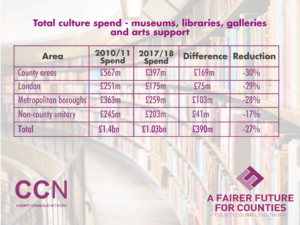
CCN Latest News, CCN News 2019 | 28 January 2019

An analysis of council spend on museums, galleries, libraries, and local arts support produced by the County Councils Network (CCN) has found that residents in county areas have seen the heaviest reductions, with councils in shire counties and rural areas reducing their spending in these services by 30% or £169m since 2011, higher than anywhere else in England.
With upper-tier county local authorities now spending on average 65% of their budgets on adult social care and children’s social service alone, county leaders have been left with little option but to re-route funding from other ‘highly-valued’ discretionary service areas like arts, libraries, and culture so they can fulfil their care obligations to the elderly and vulnerable.
The research was featured in The Independent this weekend.
County leaders say that the funding pressures they face leave them ‘between a rock and a hard place’ and argue that if government provided enough funding for care services this year in the Spending Review, it would prevent more cutbacks in cultural spend.
Metropolitan borough councils have reduced their culture spend by £104m, or 28% since 2011, London has scaled back by £75m in the same period, whilst non-county unitary authorities have reduced expenditure by £41m in the same timeframe. District councils, who do not have responsibility for libraries, but share responsibility for museums and arts support with county councils, reduced their culture spend by £3.1m. The total reduction for all councils stands at £390m.
Library services make up the bulk of these reductions, with county authorities reducing the most – down by £124m since 2011. At the same time, library visits in rural areas have reduced by 34% since 2011. Upper-tier county local authorities also record the biggest percentage reduction in arts spending – down by 70% or £22m and reduced expenditure on museums and galleries by £19m.
Arts support includes funding for local arts groups, events, projects, and festivals.
CCN warns that this trend in decreasing spend on these services is set to continue because its county authorities face a ‘triple whammy’ of being the lowest funded upper-tier councils, withstanding the sharpest reductions in government grant funding over the last four years, and face the biggest growth in demand for care services.
With the local government finance settlement to be ratified next month, CCN argues that the recent announcements from government provide short-term resource for councils, but the network has warned that the uncertainty beyond 2020 is creating ‘great financial risks’ for its councils. As part of its ‘Fairer Future for Counties’ campaign, it is calling for a fairer distribution of funding and increase resource for county areas.

This has come at a time where demand is soaring – the number of adults entering nursing care has gone up 14% in the last year, whilst counties overspent on their children’s services by £264m in 2017/18 as funding remains static.
If no additional funding is made available for councils in the Spending Review, county leaders say government needs to have an ‘honest conversation’ about what services councils will be able to deliver with demand for care continually rising. County local authorities are currently spending two-thirds of their budgets on the two care services, which is higher than other local authority types. If this trend continues, their yearly budgets will increasingly be spent on fulfilling counties’ legal obligations in these two areas.
To address severe funding shortfalls over the last few years, many local authorities have changed the way they deliver vital but non-statutory services, innovating whilst saving money. Many councils have re-shaped libraries as community hubs, spanning parent and toddler groups to elderly residents’ internet sessions. At the same time, many of them have handed over libraries to ‘community-run’ or charity initiatives, whilst moving other desk-based services online.
 Cllr Philip Atkins, Conservative vice-chairman of the County Councils Network, and leader of Staffordshire County Council, said:
Cllr Philip Atkins, Conservative vice-chairman of the County Councils Network, and leader of Staffordshire County Council, said:
“Increasing demand for care, at a time when councils are experiencing significant funding reductions, leaves local authorities between a rock and a hard place on these hugely important but non-care services.
“Councils play a major role supporting local cultural and arts organisations, and provide excellent libraries and museums. That support has not dried up completely – we spent £1bn on these services last year, whilst austerity has provided the impetus for many areas to innovate in delivering more with less. In Staffordshire, for instance, more than 20 of our libraries are community run.
“Yet with the unprecedented demand for care services continuing, we have regrettably had to shift funding from other areas to fulfil our statutory duties and more importantly protect the elderly and vulnerable. This trend is happening across all local councils, but is felt more in shire areas, where the average county spends two-thirds of its budget on care services.
“Whilst we accept this year’s finance settlement, the government must provide extra resource in the Spending Review and fairer funding for counties in the Fair Funding Review so we can preserve these highly-valued services alongside delivering care. If not, we will have little choice but to continue to cut expenditure on culture; and there needs to be an honest discussion on what role councils are expected to play in their communities as the current trends that have seen us spend more on care and less on other services shows no signs of abating.”
Notes to editor
Total culture spend – libraries, museums, galleries, and arts support
| Area/council type | 2010/11 spend | 2017/18 spend | Difference | Percentage reduction | |||||
| County area* | £567,070,000 | £397,861,000 | £169,209,000 | -30% | |||||
| London | £251,423,000 | £175,812,000 | £75,611,000 | -29% | |||||
| Metropolitan Borough | £363,302,000 | £259,317,000 | £103,985,000 | -28% | |||||
| Unitary | £245,211,000 | £203,417,000 | £41,740,000 | -17% | |||||
| Total | £1,427,006,000 | £1,036,407,000 | £390,545,000 | ||||||
| District** | £73,459,000 | £70,317,000 | £3,142,000 | -4.28% | |||||
| CCN*** | £493,611,000 | £327,544,000 | £166,067,000 | -33% | |||||
© 2024 County Councils Network | Credits | Site map | Cookies | Privacy Policy.